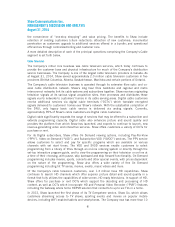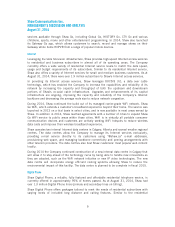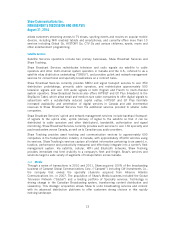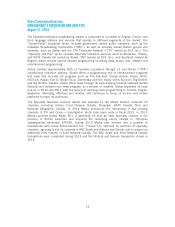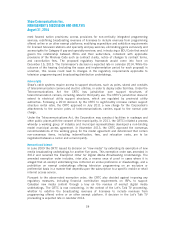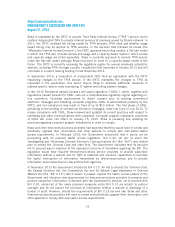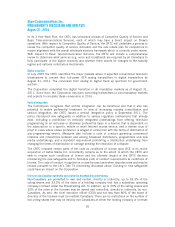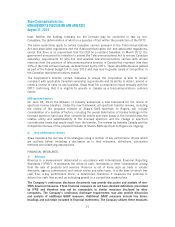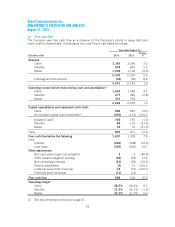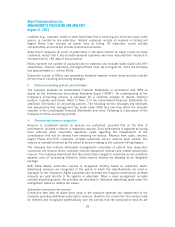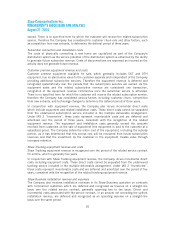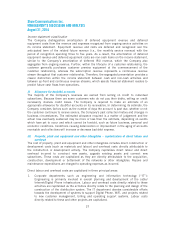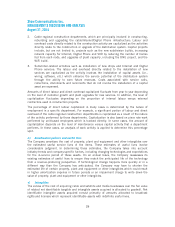Shaw 2014 Annual Report Download - page 22
Download and view the complete annual report
Please find page 22 of the 2014 Shaw annual report below. You can navigate through the pages in the report by either clicking on the pages listed below, or by using the keyword search tool below to find specific information within the annual report.Shaw Communications Inc.
MANAGEMENT’S DISCUSSION AND ANALYSIS
August 31, 2014
most favored nation provisions; access provisions for non-vertically integrated programming
services; redefining broadcasting revenues of licensees to include revenues from programming
offered online or on other exempt platforms; modifying expenditure and exhibition requirements
for licensed television stations and specialty and pay services; eliminating genre exclusivity and
access rights for Category A pay and specialty services; and, introducing a BDU Code that would
govern the relationship between BDUs and their subscribers, consistent with applicable
provisions of the Wireless Code such as contract clarity, notice of changes to contract terms,
and cancellation fees. The proposed regulatory framework would come into force on
December 15, 2015. The Commission’s decision is expected late in calendar 2014. While the
outcome of the hearing (including the scope and implementation period for each proposal) is
uncertain, this review could lead to changes in the regulatory requirements applicable to
television programming and broadcasting distribution undertakings.
Access rights
Shaw’s cable systems require access to support structures, such as poles, strand and conduits
of telecommunication carriers and electric utilities, in order to deploy cable facilities. Under the
Telecommunications Act the CRTC has jurisdiction over support structures of
telecommunication carriers, including rates for third party use. The CRTC’s jurisdiction does not
extend to electrical utility support structures, which are regulated by provincial utility
authorities. Following a 2010 decision by the CRTC to significantly increase certain support
structure rental rates, the CRTC approved in July 2011 a new charge for the Corporation’s
attachments to the service poles of telecommunications carriers equal to the normal pole
charge.
Under the Telecommunications Act, the Corporation may construct facilities in roadways and
other public places with the consent of the municipality. In 2011, the CRTC initiated a process
whereby a working group of industry and municipal representatives developed a non-binding
model municipal access agreement. In November 2013, the CRTC approved the consensus
recommendations of the working group for the model agreement and determined that certain
non-consensus items, including indemnification, fees, and relocation costs, are to be
negotiated between a carrier and a municipality.
New media and Internet
In June 2009 the CRTC issued its decision on “new media” by extending its exemption of new
media broadcasting undertakings for another five years. This exemption order was amended in
2012 and renamed the Exemption Order for Digital Media Broadcasting Undertakings. The
amended exemption order includes, inter alia, a reverse onus of proof in cases where it is
alleged that an exempt undertaking has conferred an undue preference or disadvantage, and a
prohibition on exempt undertakings offering television programming on an exclusive or
preferential basis in a manner that depends upon the subscription to a specific mobile or retail
internet access service.
Pursuant to the above-noted exemption order, the CRTC also decided against imposing any
regulatory measures, including financial contribution requirements on ISPs, to support
Canadian new media content through a levy on the revenue of exempt digital media
undertakings. The CRTC is now considering, in the context of the Let’s Talk TV proceeding,
whether to redefine the broadcasting revenues of licensees to include revenues from
programming offered online or on other exempt platform. A decision in the Let’s Talk TV
proceeding is expected late in calendar 2014.
18


